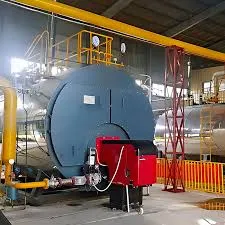
Eyl . 21, 2024 22:18 Back to list
steam boiler process
Understanding the Steam Boiler Process
The steam boiler process is a crucial component in many industrial applications, providing the necessary heat and steam for various processes. From power generation to manufacturing, steam boilers play a pivotal role in ensuring efficiency and productivity. This article explores the basic principles of steam boiler operation, its components, and its importance in various industries.
At its core, a steam boiler is a closed vessel designed to heat water to produce steam. The fundamental process begins with the introduction of water into the boiler. Heat is then applied to the water through the combustion of fuels, which can range from natural gas and oil to coal and biomass. As the water heats up, it transforms into steam, which can be used for various applications, including heating, power generation, and in certain manufacturing processes.
One of the key components of a steam boiler is the burner, which is responsible for igniting the fuel to produce heat. The efficiency of the burner directly influences the overall efficiency of the steam boiler. Modern burners are designed to optimize fuel combustion, reducing emissions and increasing energy efficiency. Additionally, the fuel type can affect the boiler’s operation, as different fuels have varying calorific values and combustion characteristics.
Another essential component is the heat exchanger, which allows the transfer of heat from the combustion gases to the boiler water. Efficient heat exchange is crucial for maximizing energy recovery and minimizing fuel consumption. Many modern steam boilers are equipped with economizers, which utilize the exhaust gases to preheat the incoming water, further improving efficiency.
steam boiler process

The steam generated in the boiler exits through a series of pipes and can be harnessed for different purposes. For instance, in power plants, high-pressure steam drives turbines to generate electricity. In industrial settings, steam is used for heating purposes, sterilization, and as a mechanism for driving various machinery.
Safety is a critical aspect of the steam boiler process. Boilers operate under high pressure and temperature, necessitating careful monitoring and regulation. Each boiler is equipped with safety valves, pressure gauges, and water level indicators to ensure safe operation. Regular maintenance and inspection are also essential to prevent potential failures and hazards.
The steam boiler process is vital across multiple industries, including energy, food processing, pharmaceuticals, and textile manufacturing. Its efficiency and reliability contribute to the overall productivity and operational effectiveness of these industries. As the demand for energy continues to rise, advancements in steam boiler technology are focusing on enhancing efficiency, reducing emissions, and integrating renewable energy sources.
In summary, the steam boiler process is an integral part of modern industrial operations. By converting water into steam through the combustion of fuels, steam boilers provide essential heat and energy for a wide range of applications. As technological advancements continue, the steam boiler process will evolve, promoting greater efficiency and sustainability in various sectors. Understanding and optimizing this process is essential for meeting the growing energy demands of the future while minimizing environmental impact.
-
Best Steam Boiler Design PDF Free Design Calculation & Diagram Downloads
NewsJun.10,2025
-
Hot Boiler Water Heater Efficient Heating Solutions for Home & Commercial Use
NewsJun.10,2025
-
Steam Boiler Safety Devices High-Quality Protection Valves
NewsJun.10,2025
-
Ultimate Steam Boiler Checklist for Safety & Efficiency
NewsJun.10,2025
-
Optimal Hot Water Boiler Temperature Setting Guide
NewsJun.10,2025
-
Effective Hot Water Boiler Chemical Treatment Protect & Maintain
NewsJun.09,2025
Related PRODUCTS






















